| |
The L-39 Albatross, She Flies !!
From: Grant Calkins email: CasinoOp@worldnet.att.net
The caravan carrying the Calkins-Cannon consortium (Grant Calkins and Ray
Cannon) left Camarillo, CA in the pitch dark at 5 A.M. bound for the model flying field at Edwards AFB on the edge of
California's Mojave desert. Contained in the hold of Ray's Dodge Caravan was precious cargo indeed - three electric ducted
fan (EDF) airplanes, two of which were headed for their maiden flight. The destination field is very special. It is 2 miles of flat
dry lake, within the boundary of historic Edwards AFB, and hot as a pistol in Late July. As the van proceeded out of cool
Camarillo, the various flight batteries were charging and the pilots quietly wondered what was in store for these one-of-a-kind
scale models so carefully crafted and assembled over the many months. We would soon find out.
Two hours, and about 40 degrees later, we pulled into the flying site. Tony
Frakowiak, master R/C pilot, employee of the Dryden Flight Test Center at Edwards, and fellow member of Muroc Model
Masters R/C club, was there to greet the consortium. Tony would be maiden-flying the two brand-new models for us, but was
currently occupied flying his Bandit turbine jet through "camera runs" 20' off the deck at about 150 mph. Our planes
were:
1. Ray Cannon's magnificent XB-70 bomber, 8' long, 13 lb., and featuring 4 WeMoTec-Plettenberg power plants providing
over 5 lb. of thrust from 28x2000 mAh NiMH batteries. It is painted white with black trim just like the real thing, with retracts
and closing doors, it is a seriously excellent model cad-designed by Ray and requiring over 6 months to build.
2. Grant's, 48" WS, 49 oz L-39 Albatross with it's 11x2000 mAh NiMH battery, and powered by a single
WeMoTec-Velkom power plant drawing 240 watts. A scale model of the famous Chek jet trainer, done in white and gray with
fluorescent wing and tail tips.
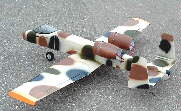
3. (non maiden light) Grant's A-10 Thunderbolt (the 'Warthog') with two cut down WeMoTec impellers driven by hot speed
480 motors custom assembled by Jim Winters of Tucson, AZ. This plane has flown several times, and is a proven
scale-but-docile model that turns heads whenever it flies.
As Tony landed the Bandit, Grant filled the sky with Warthog while Ray readied
the XB-70. This plane is a crowd magnet, and Ray was busy answering questions from civilian and Air Force people alike who
had wondered onto the lakebed at 7 A.M. before proceeding to work at the base 14 miles away. There had been a concern that
the B-70 was "too heavy on the nose" to ROG, but only trying would tell.
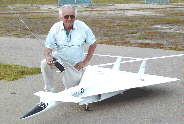
When all was ready, Tony applied full power and the cobra-like bomber started
down the lakebed, gathering speed. It steered perfectly on the ground. But unfortunately, the nose-heavy fear was well
founded, as the plane refused to lift it's slender nose. Another try gave the same result, and so, despite the urging of the
ever-gathering crowd, the XB-70 was "hangared" to await modest rework back at the shop.
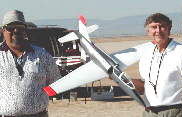
The L-39 was next up. This model requires a bungee launch, so Calkins strolled
across the ever-hotter lakebed to drive the stake. A second safety stake was also used 6" from the first (we didn't want
an accidental flying stake heading for the launch personnel). With Tony applying a "little up" and full power, Ray let
go of the L-39 and the model rocketed across the lakebed surface and leaped skyward in about 20 feet. It flew off the bungee
and continued pointing upward until Tony leveled off around 100 feet. This plane is a rocket, even in 95 degree air at 2700 ft.
altitude! Tony throttled back and flew some "camera runs" while Grant and Ray were busy taking video, digital stills, and film
shots like mad. The plane, now a proven flyer, Tony settled the model back onto the surface as smooth as a baby's bottom. No
major flight issues, but a little less low-rate aileron would be helpful.
Two flights, one gallant attempt, no broken models, and Calkins and Cannon
headed for the traditional maiden-flight watering hole in nearby Rosamond called the Skillet. Being just 10:30 am the fare called
for the Jackass Kick'en omelets with grits all around. Three hours and only a little heartburn later, the Consortium had left the
105 degree desert behind and was back in cool Camarillo looking forward to new challenges.
Grant Calkins and Ray Cannon
Channel Islands Condors, Muroc Model Masters at Edwards AFB, California
Return to "What's In This Issue?"
Improved Setup for High Cell Count Twins
By Keith Shaw
(A while back, Keith drew up this diagram and made the following notes for
this twin wiring diagram. Please note that the motor leads in the diagram are considerably shorter than would be in real
life, and the motors are turned 90 degrees from "normal." KM)
Notes:
1. It is important to use two digital 204 controllers, so that the motors will be in sync.
2. Both packs must be the same number of cells, cell type and age.
3. If you have two 112D chargers, both packs can be charged at the same time. It is okay to charge them one at a time as well.
4. Before flight, arm pack A and make sure the motors start. Then, disarm pack A and arm pack B. Check to make sure the
motors run. Rearm pack A and go fly.
This is about the only practical way to run two 40ís, particularly if you want to use
more than 18 cell motors.
The packs, wiring, switches, charge jacks and controllers are in the fuselage or
center of the wing with long wires out to motors in nacelles.
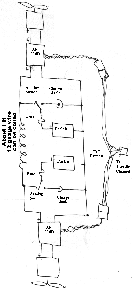 Return to "What's In This Issue?"
Return to "What's In This Issue?"
Swedish Casa 212 Aviocar now flying!
From: Bertil Klintbom email: bkm@algonet.se
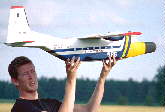
Dear Ken,
Here are some photographs of my Casa now fully test flown. I use 2 speed 400 with
mini-olympus gearboxes, low budget but well performing. I get 9-10 minutes from a 8 cell 2400 mAh nicad. The model is a stable
and excellent flyer. I have had no problems at all during the test flights with the models behavior. On the contrary, on the first
flight I flew large circles to check out the model. After about 5 minutes the model suddenly felt harder to turn to the left. I made
a full left hand circle and landed. When the model had stopped on the ground the right hand propeller continued to turn and I
realized that I had lost the motor shaft gear and that the propeller was freewheeling! The set screw was not tightened enough.
The model does fly very well, and I think it is a 100% success.
Best regards, Bertil Klintbom, SWEDEN
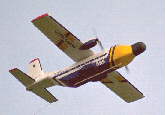 Return to "What's In This Issue?"
Return to "What's In This Issue?"
Cutie Power
(Last month I reviewed the SR Batteries Cutie and gave some alternate
power suggestions. Bernard Cawley sent an email with the following suggestion for a brushless system. KM)
Another choice to add to your suggested power systems: Jeti Phasor 15-4 and 30A
controller. It would pull the Cutie up in a BIG hurry and swing a bit more prop than the MM.
I'm using an APC 9X4.5 thin E prop on 7 cells on the 15-4 in the Electric Scout. To
get the current draws you want (25A), that would be a good place to start on 6 cells.
(Remember folks, we are not suggesting "over-powering" this
model to "improve" it. It is excellent as a park flier the way it is. This is only if you want a plane to fly in a
mixed environment or a "sportier" 3-channel plane. You will give up some of its docile flight characteristics
if you go to a heavier power system. KM)
Return to "What's In This Issue?"
The September & October Flying Meetings
Both meetings were held at the Midwest R/C Society Flying field on 5 Mi. Rd.
The September meeting found us with some of the very best flying weather of the
year. Sunny skies, warm and light breezes. There were a lot of different types of planes in the air at all times. We also added a
new member. Welcome aboard Roger!
Saturday, October 13 did not promise to be as good a day. The cloud cover was
heavy, and the ceiling a little low. Right Don? ButÖ it turned out to be an excellent day. Even though the weather was so iffy,
there were about a dozen pilots and a lot of aircraft present. While the winds were light to moderate, that didnít bother the pilots
present. We broke around noon for a field lunch; hotdogs, chips and soda. There was more flying, until the rain drops appeared
at about 1:30.
Now we can look forward to our Michigan building season, indoor flying at the
Oakland Yard, and April, when we start up our flying meetings once again.
Return to "What's In This Issue?"
SKS Mid-America Video Ready!
The SKS video of the Mid-America Electric Flies 2001 is ready. It is an excellently
produced video and can be purchased for $19.95 + S&H.
U.S. Call Toll Free: 1-800-988-6488
or
SKS Video Productions
85 PINE ROAD
ABBOTTSTOWN, PA 17301 USA
By Fax:
1-717-259-6379
Or on the Web at: www.sksvideo.com
Iíd like to suggest that this would make an excellent holiday gift. Hint, hint!
Return to "What's In This Issue?"
Pacific e Scale Championships
From: Doug Burt flyinace@direct.ca
Here are the results of the Pacific e Scale Championships held out here in
Chilliwack, BC on July 28-29, 2001. Unfortunately the weather was absolutely horrible on Friday and most of Saturday so
attendance was way down from what we had anticipated but nevertheless we managed to fill all categories and hold an official
event. Here's the results;
Sport Scale
Static Judging
1. Gerard McHale, Blackburn Monoplane
2. Darren Bos, Santos-Dumont Demoiselle
3. Jamie McBride, Porterfield Collegiate
Flight Judging
1. Gerard McHale
2. Darren Bos
3. Jamie McBride
Aggregate Totals:
1. Gerard McHale
2. Darren Bos
3. Jamie McBride
Stand-Off Scale
Static Judging
1. Hal Norrish, DeHavilland Buffalo
2. Gerard McHale, DeHavilland Beaver
3. Todd Long, Ivan Pettigrew (Team), Auster
Flight Judging
1. Gerard McHale
2. Hal Norrish
3. Todd Long, Ivan Pettigrew
Aggregate Totals:
1. Hal Norrish
2. Gerard McHale
3. Todd Long/I.Pettigrew
Expert Scale
Static Judging
1. Bob Benjamin, Aeronca "K"
2. Ivan Pettigrew, Mosquito TIII Trainer
3. Bob Benjamin, Bowers FlyBaby
Flight Judging
1. Bob Benjamin, Aeronca
2. Bob Benjamin, FlyBaby
3. Ivan Pettigrew
Aggregate Totals:
1. Bob Benjamin, Aeronca
2. Ivan Pettigrew
3. Bob Benjamin, FlyBaby
Results are posted on-line with photos at
www.canadianelectricflight.com
I would also like to thank MaxCim Motors, Astro Flight, MEC, Bob Banka's Scale
Documentation, Bob Benjamin's FlightImages, Todd's Models and BSI Adhesives very much for graciously contributing prizes for
our event. See you again next year...
Doug Burt, CD
Pacific e Scale Championships
Return to "What's In This Issue?"
Upcoming EFO Meeting
The December EFO meeting will be starts with refreshments at Kenís house about
7:00 P.M. on Saturday, December 8, and then it will be moving to the Oakland Yard for some spectating and indoor flying. As in
the past, the EFO will pay the fee for spectators, but youíll need to pay your own fee for flying, or be a member of the Oakland
Yard Flying Club. Everyone, EFO member or not, is invited to join us for this fun evening starting at KenĎs house in Walled
Lake, MI.
Return to "What's In This Issue?"
Oakland Yard Indoor Winter Flying '01-'02
For the Winter info, click here.
Use your browser's Back button to return to this page.
Return to "What's In This Issue?"
The Saga of the PT Electric or
A Little Problem Solving
Subj: P. T. Electric
From: Merle Davies mp_davies@yahoo.com
(I hope to show, with this exchange of emails, how we can work together to
come up with a good power selection for a given model. It all started with an email from Merle. KM)
Hi Ken,
Last Sunday I had motor power problems with my "P.T. Electric" flyer.
With a Sanyo 7 X 1500 mah battery pack the model would not climb after three ( 3 ) hand launches. Finally ended up as a front
end repair job. Aircraft has not been flown in two years, battery pack was recycled before use, with installed motor , a Great
Planes "Thrust Master" 05 supplied with the kit. Some of my peers suggested replacing the motor for more needed
power.
(I have on hand a OLDER "Astro 05" with the "fit - around"
white plastic mounting, purchased at a Swap Shop, and a Astor Cobalt 05, NEW, and unused. I would be interested in your
comments on a replacement to correct my power problem. Either motor will require rebuilding the motor mounting facilities.
Thanks for your help.
Hi Merle,
(Let's see if we can figure out what to do. First, I need a little information.
What brand and model type speed controller are you using?
What brand/type of connectors are you using?
What charger do you have?
Did you slow charge your pack before using it, after its layover?
This will help us get a start on it.
What brand and model type speed controller are you using?......."FX 35 DIGITAL"
What brand/type of connectors are you using?.........SERMOS CONNECTORS
What charger do you have?.......ROBBIE "INFINITY" MODEL 1...PEAK CHARGER.
Did you slow charge your pack before using it, after its layover? NO "SLOW CHARGE", ONLY FOUR
RECYCLE SEQUENCES. WHAT CHARGE ON PACK BEING USED ?
This brings us down to two things, either the speed control or the motor.
You can check out the speed control, as I mentioned above. One thing I forgot to ask is what prop, diameter and brand are you
using?
WINDSOR ELECTRIC, PLASTIC PROPELLER 8X4.
You didn't say whether or not moving the throttle trim on the transmitter, with the throttle set at high changed
the RPM. Did it?
I did some calculations today using the estimated data for the Thrustmaster:
Kv = 1890
Ra = 0.125
Io = 2.3
I found that a 9x5 prop should still work safely direct drive. That surprised me! You might want to give that a try. If you have
access to a 9x5 APC or 9x5 electric APC, give it a try. You have nothing to lose, since you are thinking about replacing the
motor.
This should "fly" the plane.
I do hope that you realize that Great Planes has not recommended the correct power system for this plane. If you are going to
use that motor, it should be geared 2.22:1 using the Olympus Belt-Drive, 10 cells and a 10x7 prop. This also means that a BEC
type controller can't be used, unless the BEC is disabled and a 270 mAh Rx pack is used. That shouldn't be a problem, as the
AUW (all up weight) should end up around 62 oz., and the wing loading only near 18 oz./sq.ft. Not bad at all for a trainer.
Right now I'd say try a 9x5 prop and see what you think. Secondly, pick up the Olympic Belt-Drive and a 10x7 prop, aeronaut
or APC electric and give it a try after modifying the mounting for the belt-drive. This will give you some things to do. Let me know
what happens, please. Remember that you can disable the BEC on the FX-35D when using a 270 mAh Rx pack.
Utilized a wet, non fly Sunday, to be with a wise club member checking my "PT Electric" A comparison of two
like motors resulted in the crashed motor having the lesser power of the two motors under test. Will install a Astro 05 Direct
Drive motor as a replacement when rebuilding. Thanks for your help. Merle
Return to "What's In This Issue?"
Live in Canada?
(Itís been a while since I mentioned our good friends living east of here.
KM)
The Electric Model Flyers of Southern Ontario (EMFSO) is the first electric
model flying club in Canada. We are a non-profit organization devoted exclusively to promoting and supporting electric
powered flight. Anyone interested is encouraged to join the club and share knowledge with fellow members of all skill levels
and focuses. We have about 200 members, mostly in and around the Greater Toronto Area, and we have many fun flies, both
indoor and out, several workshops and meetings, and we publish a newsletter about 5 or 6 times a year. Membership is $15
Cdn for Canadians and $15US to non-Canadians.
You can visit their Web site at: www.emfso.org
Return to "What's In This Issue?"
Computer Radio Responses
From: Urs Szymanski szymanski@urbanet.ch
Hello,
First thanks for your online magazine, always good and informing....interesting to
read......but I must take exception with your editorial about modelmemories stored on computer radios causing accidents. It is the
people behind the radio who are responsible for their radios and for seeing that they have the correct memory for the particular
model they are about to use. (Couldnít agree with you more! KM)
I have done my fair share of stupid things in 50 years of modeling and I accept
responsibility for them. I definitely do not blame them on the computer radio. A bad workman always blames his tools. It was a
valid expression pre-computer era and is STILL valid today.
Thanks,
Urs Szymanski - Switzerland
From: John Rossetti jyuma@axxent.ca
Hello Ken,
Your editorial on the use of transmitters with more than one plane on them was
well put. I can tell you from experience that I have, several times, tried to fly with the wrong plane programmed in. In one case,
before I went into electrics, I spent over an hour in the hot sun trying to find out why I had no throttle on my 1/4 scale Sig Cub.
Fortunately, because it ran only at full throttle I never attempted to fly. Once or twice this summer myself and one of my close
flying buddies have had the motor turn on without warning ... dangerous. You have to be extremely careful, from a safety
standpoint if nothing else, and to prevent an unexpected crash as well.
I enjoyed your comments on "park flyers" and while I believe there is
some danger from an interference aspect, the most unfortunate part is that we do have, as you mentioned, some "lone wolfs
( wolves?)" who miss all the benefits of associating with other model builders.
Some great photos in this issue and it looks like electric is hear to stay.
Regards,
John Rossetti
From: Greg Potter Potter.Greg@saugov.sa.gov.au
Ken,
I've seen a flyer who uses multiple transmitters pick up the wrong transmitter for the model he
was trying to fly. You can't make everything idiot proof. People make mistakes whether it's setting the wrong model memory,
picking up the wrong TX, forgetting to switch the Rx on, forgetting to hook up the elevator push-rod on a removable tailplane
(I've done this one twice), putting in mismatching crystals etc. etc. It's not the transmitter that causes the problem!
I could not afford to fly all the different models I fly if I did not use a multi-memory
transmitters, and yes I have done the "wrong model" trick, fortunately with only minor damage. The model I had
selected incorrectly had reverse elevator and rudder movements to the one I was trying to fly.
If you use one of these transmitters, you just have to a have a routine that as soon
as you switch on you go to model selection.
I like the Multiplex because it has 99 model memories, and as soon as you select a
new model memory, it takes you straight to the trim setting screen to show you where the trims were set the last time you used
that memory (much better than the JR method).
I'd have to have about 10 different transmitters (maybe more) to cope with all my
different models.
However I agree with you about the parkfliers. While I fly on my own many times
I enjoy the company of other flyers at a club field or a contest. I think all new R/C flyers should have some level of instruction
regardless of what they are flying but how do you enforce it?
I found Allan Flowers email address, it was on one of his web pages that I had not
looked at initially. Have you seen one of his Fokker DVIII kits close-up? (Sorry, no, but they sure "look good"
on paper. KM)
Regards,
Greg Potter
From: Steve Moskal cometkid@flash.net
Hi Ken,
Great job with the September issue.
I understand your Luddite editorial on programmable transmitters. But, some of us get talked into the ever-greater, cooler, modern concepts by other well-meaning club members. I was talked into buying an Airtronics Stylus at Toledo three years ago because:
A) It was being sold by a vendor at a great price and
B) My club member friend said "It's the only radio you'll ever need from now on."
OK, so I brought it home and discovered that I needed a 50 model memory card
and a sailplane feature card (I should explain that these radios with their many mixes and switches are needed by fliers of
modern full-house sailplanes. And. . .sigh, I was talked into buying a used Emerald sailplane from a club member who was
almost giving it away.) and I learned another lesson. If you want to fly a Zagi 400 with elevons, you must have a 7 channel RX.
This radio system needs to have channels 1 and 7 if you desire elevon mixing! Ouch!
Well, I find that flying the modern full-house sailplane isn't for me. It is most
definitely not as relaxing as an RES or Nostalgia Class (I'm 55 years old, so I actually remember all the Nostalgia-legal
sailplanes!) glider.
This season all, and I mean ALL, my electric choices were instant rekits. I flew a
Kyosho T-33 twice and crashed it twice - all from a cruise. I mean no rolls or loops. It just snapped in. And the MultiPlex
TwinJet mashed into the ground when I got it in the sun and was disoriented.
So, what's left? My Playboy Cabin Old timer, my Zagi 400 (My slope Zagi's need
north winds on the closest slope to me - the dunes at Warren, MI.) and a Pico Stick.
Which is a neat segue into the Park Flyer piece you wrote. When I was flying my
Stick at a soccer field a 30ish walker stopped and asked me where and how to get one. He'd "always wondered how they
flew after seeing one in the Sharper Image catalog." No fears that this man will turn into a lifelong modeler, Ken.
'Cause only a lifelong model builder could put up with all that I've done and still come back for more punishment i.e. - try to learn
and build new models. So, foolish lad that I am, I've just finished a Speed 280 powered (see attached) Facetmobile.
(pictured below) Wish me luck!
Steve

From: Stefan Vorkoetter stefan@capable.ca
Dear Ken (Luddite) Myers:
I agree with you about the problem of selecting the wrong model in a computerized
transmitter. This hasn't happened to me, and there are a few things I do to avoid it being a problem if it ever does.
First, I set up all my models relatively similarly. Most importantly, all the control
throws are in the same direction. I use the computerized features to add things like mixing, rates, and support for special features
(like the camera on my Riser 100). Therefore, if I do fly with
the wrong model memory, at worst things will respond slightly differently than I'm used to, but the model will still be safely
flyable.
Second, although the transmitter allows me to name models, I also put the
program number on the rudder of the model.
One exception: I've modified my Great Planes Spectra to have a V-tail, so that
model is programmed with a V-tail mix. But even a cursory control surface check immediately shows that I'm using the wrong
program in that case.
By the way, if you're setting up a model, and a control surface moves the wrong
way, and there's no room to change the linkage so that it can move the right way without reversing it at the transmitter, there's
an easy fix: change servo brands. Futaba servos rotate the opposite direction of JR and Airtronics servos. I'm a JR guy, but I
have a few Futaba servos (actual Futaba brand - Hitec servos with Futaba plugs rotate the same way as JR servos) that I use
for such situations.
Stefan Vorkoetter
Return to "What's In This Issue?"
St. Julie Fun Fly
From: Scott Black sblack@progression.net
Here are a few of the outstanding airplanes that we had at the Quebec Electric Fun
fly, hosted by the C2VM club and CD'd by Paul St. Arneau.
It was a small get together which made it in a way even more fun. No waiting for
a pin, miles of sod, no clouds no wind, tons of cool planes to fly and watch and some racing too.
Here is a brief description of the airplanes:

EAM Mig 17, J.C. Terrataz, Aveox 1409/2Y, 12 - 1250 cells

Caprise pattern ship (scratch built), S. Black, Astro 05BL, 8 CP1700s

Kress F-15, Paul Penna, Plett 200/20/6, 10 1250 SCRs, MF480

F86 (scratch built), S. Black, Hacker B50-13L, 16 CP1700s, HW609 fan

Great Planes CAP, Louis Dionne, Astro 40 Geared, 18 2400 SCRs (I think)

Kyosho T-33, Paul Penna, Hacker B40, 10 1250s

Comet on launch and in the air.
The cool pictures are courtesy of Scott Johnson.
Oh, and C2VM stands for Club de Vol de la Monteregie. Sorry you asked ? Roughly translated that is Flying Club of the Mountain Region I suppose.
Cheers,
Scott Black
Return to "What's In This Issue?"
MachineWorks NorthWest
CockpitMaster is available direct from
www.cockpitmaster.com
We have a downloadable version ( 49.95$ ) and CD version ( 57.95$)
We also have a new Sim coming up, "Backyard Edition", focusing solely on small electrics, starting at 29.95$ for the download version.
CockpitMaster RC Simulator is a made by MachineWorks NorthWest LLC
Return to "What's In This Issue?"
To Reach Ken Myers, you can land mail to the address at the top of the page. My E-mail
address is:
KMyersEFO@aol.com
EFO WEBsite: http://members.aol.com/KMyersEFO/
|
|















